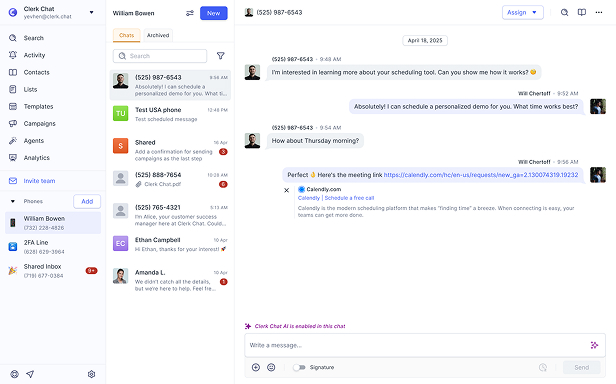How to Improve Customer Service in Financial Services (with a little help from AI)
By Alexander Haque
- Published: April 3, 2025
Most business leaders know that delivering exceptional customer service is the key to success in any industry. After all, 73% of customers say that the “experience” they’ll get from a company is a crucial factor in guiding their purchasing decisions. But providing great customer service in financial services can be more complicated than it seems.
Customer expectations are shifting, with 72% of consumers looking for immediate answers to questions, and 62% saying a “personalized” experience is crucial. Beyond that, clients are turning to new communication channels for support (like text messaging solutions for banks), and they’re encouraging companies to be more “proactive” with their service strategy too.
All the while, financial services and banking companies need to make sure their service strategy adheres to strict compliance standards and regulations. It’s a tricky path to navigate – but there are ways for companies to enhance their service strategy, improve customer satisfaction rates, and minimize turnover. Here’s your guide to optimizing customer service in banking and finance.
In this article:
The Importance of Customer Service in Financial Services
Let’s start with an insight into why it’s so important to prioritize customer service in the banking industry. Ultimately, excellent customer service is the key to creating a successful financial firm.
Although great customer service is critical in any industry, it’s particularly important in industries that rely heavily on “trust.” Whether you’re offering access to insurance services, banking, or investment solutions, customers need to trust you to put their “livelihoods” in your hands.
Unfortunately, the financial services industry has often struggled with earning and retaining customer trust. There are various factors that can contribute to this mistrust, from unpredictable economic conditions, fluctuating interest rates and more. However, there’s one thing financial services companies can control: how they serve their customers.
Your approach to serving and supporting customers is how you ensure your clients feel valued, appreciated, and respected. It’s what ensures you can keep your clients around for as long as possible. In fact, one study found that 73% of financial services customers will quickly switch to a competitor after just a few bad experiences.
However, if your approach to customer service in financial services is consistently good, you’re more likely to earn your customer’s loyalty, and stay one step ahead of the competition.
In financial services, exceptional service is non-negotiable.
Clerk Chat helps you build trust.
The Challenges Financial Services Teams Need to Overcome
Financial services companies face the same challenges as countless other organizations when it comes to optimizing customer service. They need to navigate ever-evolving customer services software and technologies, adapt to changing priorities and preferences, and stay agile.
However, there are a few unique challenges involved in mastering customer service in banking and finance too:
1. Handling Complex Conversations
Financial services and products can be complicated – and customers need help understanding how they work, their risks and benefits, and how they can address complex problems. This means every professional responsible for delivering customer service in financial services needs to be extremely knowledgeable. They need a deep understanding of how products, services, and policies work, and they need to be able to translate complex ideas into messages customers can understand.
That’s one of the reasons why it’s so important to constantly invest in training your customer service team and giving them the information they need to support and guide customers.
2. Balancing Personalization and Compliance
71% of customers now expect businesses to personalize every interaction. That means everything from the troubleshooting guides you share with customers to the SMS appointment reminders you send needs to be deeply personalized. However, financial companies are also subject to strict compliance guidelines that dictate how they can share, store, and use customer information.
Balancing personalized experiences (like suggesting specific products and solutions to customers based on their needs), with privacy and compliance standards can be complex. That’s particularly true as new governance guidelines and regulations emerge.
3. Maintaining Consistency Across Channels
Today’s financial services and banking clients don’t just interact with companies face-to-face or over the phone. They chat with conversational AI chatbots, send text messages to companies, and even schedule video conferences with advisors. Companies need to be not only available to connect with clients on the channels they prefer – they also need to maintain consistency.
Customers don’t want to repeat themselves, or navigate different “service” experiences based on the channels they choose. They want everything to feel smooth and consistent, regardless of how they want to interact with your company.
How to Improve Customer Service in Banking and Finance
Enhancing customer service in financial services requires a multi-level strategy. For most companies, it will involve a careful consideration of everything from embracing new technology and software, to training team members and navigating compliance issues.
Here are some top strategies companies can use to upgrade their customer service approach.
1. Embrace the Era of Omnichannel Communications
According to a trends report from Zendesk, 64% of customers spend more when they can resolve issues with a bank or financial company on the channels they’re already using. This makes it crucial for finance companies to embrace “omnichannel” communication.
Designing an omnichannel customer service strategy isn’t just about making sure you can communicate with customers through the phone, finance SMS tools, chat apps, and even social media. It’s also about ensuring all of those channels are aligned and connected.
Make sure the information collected by AI bots can be transferred to team members who take over a chat or voice-based conversation. Ensure your team members have a clear view of every stage in the customer journey before they jump into a discussion.
2. Explore Self-Service Options
One major challenge financial services companies face with customer service is that they can often struggle to respond to issues quickly. Since customer requests and queries can be complex, conversations with clients can consume a lot of an agent’s time, leading to long call or chat queues.
One of the best ways to address this issue (aside from hiring additional staff), is to invest in self-service solutions. For instance, conversational AI in financial services is transforming customer service by allowing companies to create intelligent AI agents that can respond to common queries and complete tasks – like checking account balances or suggesting products to customers.
With AI for insurance agents, companies can even allow clients to submit claims and request forms without ever having to speak to a human agent. You can even create guides, video tutorials, FAQs, and knowledge bases to help your customers help themselves.
Introducing self-service options allows customers to resolve issues faster, and it reduces the strain on your human service teams, while reducing call queues.
3. Invest in Continuous Training
As mentioned above, to excel at customer service in banking and finance, customer-facing experts need to be extremely knowledgeable. They need to understand your products and services, the challenges facing your clients, industry regulations and more.
Ensuring your team members have the right skills to thrive in their roles means investing in continuous training. Don’t just invest in a great onboarding process for new staff members, focus on a consistent approach to developing your team members.
Introduce them to new technical skills, teaching them how to use CRM systems and software to manage customer service tasks. Invest in their soft skills too, ensuring they know how to show empathy, communicate clearly, and solve problems effectively.
You can even take advantage of AI to help with this. AI tools can track the quality of the conversations your service agents have, offering insights into weaknesses that need to be addressed. Plus, you can use AI agents to deliver coaching and feedback to professionals in real-time.
4. Master Compliance
Overlooking the importance of compliance in the financial services industry doesn’t just put your company at risk of fines and reputational damage – it can harm the customer experience too. Make sure you know the rules you need to follow when it comes to collecting and storing customer data and conversations with clients.
Look into compliance guidelines that will affect your marketing and sales strategies too – such as TCPA compliance standards or SEC regulations related to text messaging if you’re going to be using text messages for communication.
Invest in intelligent archiving tools to prepare yourself for potential audits and complaints, and take advantage of real-time monitoring tools to help you detect compliance issues. For instance, AI-powered solutions can help you detect when sensitive information is revealed in a discussion, so you can adjust how you store or archive data.
5. Use Personalization and Customization
As mentioned above, great customer service in financial services relies heavily on personalization. Customers want support that’s tailored to their specific needs. Think carefully about how you can make every experience more “unique” and customized for each client.
Use a CRM system like Salesforce or Microsoft Dynamics to gather data about customers, and segment them into groups based on their preferences, needs, or the products they’ve purchased. Ensure your team members can access this data, not just when they’re addressing customer problems, but also when they need to craft effective promotional messages or campaigns.
When you’re using AI in your customer service strategy, make sure these tools can safely tap into customer data too, to give personalized product recommendations and suggestions.
6. Leverage Feedback Mechanisms
Data is incredibly valuable when you’re looking for ways to improve customer service in financial services. The data you collect from platforms, like your CRM system, contact center tools, and communication apps can give you an excellent insight into different stages of the buyer journey, and customer preferences. However, it’s worth going beyond that quantitative data too.
Create a feedback loop to source genuine insights from your customers. Send out surveys with customer service SMS templates to learn more about potential friction points and issues. Experiment with CSAT surveys, to track satisfaction rates, and NPS (Net Promoter Score) surveys.
Consider using social listening tools so you can track what customers might be saying about you on other digital platforms, like review websites and social media channels too.
7. Be More Proactive
According to a Forrester survey, more than half of all customers want their banking and financial services providers to be “more proactive.” They’re looking for companies to take an intelligent approach to sharing relevant information and advice with them.
So, consider taking a more proactive approach to customer support. Instead of waiting for a customer to contact you about when a next payment is due, use payment reminder SMS templates. When your technology has an issue, let customers know about it in advance.
Whenever you create a new product or service, use your CRM system to find the customers most likely to benefit from that solution, and send them a quick message. Or, if you notice a customer experiencing financial issues, reach out with budgeting strategies or an invite to a consultation.
The Role of Technology in Enhancing Customer Service
While there are a number of strategies that companies can use to improve customer service in the banking industry or financial services sector, many rely on access to technology. For instance, to implement an omnichannel strategy, you need flexible cloud-based solutions for communication that integrate seamlessly with each other.
You’ll need to ensure your contact center software supports a range of channels like voice, video, social media, and customer service SMS solutions. For an omnichannel strategy, you’ll also need to ensure you have technology in place that can help to route your customers to the right agent or environment regardless of which channel they contact you through.
You must also make sure the technology can integrate with other innovative tools too, such as:
AI-Driven Solutions
As artificial intelligence in financial services continues to evolve, there are countless AI tools that can enhance customer service in the financial services industry today. We’ve already mentioned a few, such as:
- Chatbots and conversational AI assistants: While standard chatbots can only respond to simple queries based on rules, conversational AI assistants (like the Clerk Assistant) can understand natural language and context, to help with a wider range of self service tasks. They can even recommend products to customers based on their specific needs.
- Agent assistance tools: AI bots designed to assist agents in the financial services sector can surface information from different environments quickly, and offer real-time training and coaching to team members – making them more efficient and productive.
- Automation tools: With automation and AI, companies can take a more proactive approach to customer service. For instance, you could use an AI-powered text messaging solution to automatically notify a customer about a change to a product or service policy.
All of these tools help companies to scale customer service strategies, improve your customer service response time, and reduce costs by boosting team efficiency and productivity.
In financial services, exceptional service is non-negotiable.
Clerk Chat helps you build trust.
CRM Solutions and Data Platforms
Customer Relationship Management (CRM) tools are essential to capturing valuable information about customers and creating personalized experiences. Financial services clients are happy for companies to use the data they gather about them to deliver more intuitive, relevant experiences.
Make sure you’re using your CRM solution to contact customers on the right channels at the right time - and suggest relevant products, services, and solutions. You can even integrate SMS with your CRM to help you build more personalized conversational banking strategies.
For instance, with a Microsoft Dynamics SMS integration, you can use the data you collect about customers to send automated messages to specific clients when they’re eligible for a new product or service. AI tools can also tap into your CRM solutions to suggest specific products to customers based on their purchasing history or unique needs.
Analytical and Reporting Platforms
As mentioned above, data is incredibly important to customer service in financial services. Analytical and reporting platforms allow you to gather and unify various forms of data to make more intelligent decisions for growth. For instance, you can use these tools to gain insights into your customer service agents’ performance – tracking metrics like average handling times and customer satisfaction rates.
You can combine these insights with the feedback you receive from customers, potentially discovering new ways to improve client loyalty. For instance, if your data shows you that customers constantly have to wait long periods to speak to an agent, you could decide to implement conversational AI for insurance, banking, and finance advice delivered 24/7.
When you’re collecting data in the financial services sector, remember to go beyond simply looking for valuable insights. You also need to make sure you’re storing data according to compliance standards. Invest in secure text messaging archiving for financial advisors and experts. Consider experimenting with other tools to boost security too, such as multifactor authentication and end-to-end encryption for communications.
Excellent Customer Service Examples
Sometimes the best way to get a clear view of what great customer service in financial services looks like and build the ideal strategy for your company, is to learn from the professionals. Here are some great examples of companies that excel at delivering great customer service.
1. Starling Bank
British Neo bank, Starling Bank, has an excellent reputation for delivering phenomenal customer support and guidance. They ensure customers have access to support every day of the year – on a 24/7 basis – even during holidays and weekends.
Customers can get in touch through chat apps, two-way text messaging, phone calls, and conversations with AI bots and more. Plus, every agent is trained on all of the services and products the company provides, so customers don’t have to spend time waiting for the specialist with the “right knowledge” to be available.
2. Nationwide
Another excellent example from the UK, Nationwide Building Society shows its customers how much it cares with a proactive approach to service. During the pandemic, the company not only extended payment holidays for customers with economic hardships – using data from its CRM, it also invested in a rich SMS strategy to support clients.
The company used SMS to send personalized advice to each customer about the steps they could take to maintain their financial health during a difficult period. Nationwide continues to take this same proactive approach today, with an omnichannel messaging strategy.
3. Belfius
A great example of how AI is revolutionizing customer service in the financial services industry comes from Belfius – one of Belgium’s largest banks. This company decided to streamline the process of filing insurance claims for its customers with a customized chatbot.
The chatbot, powered with conversational AI for customer service, can understand customer insurance requests, and process applications without any human intervention. This means that customers can submit applications at any time, without having to wait for an agent. It can also personalize customer conversations with insights from the company’s knowledgebase.
Take Customer Service to The Next Level
Mastering customer service in financial services can be complicated. There are numerous challenges to address, from understanding the compliance rules of marketing for tax professionals, insurance agents and banks, to adhering to changing customer expectations.
Fortunately, the right technology can help. Solutions like Clerk Chat, an SMS-first business communications platform, make it easy for companies to embrace omnichannel service with support for messaging apps, voice, video (via integrations), and SMS.
With Clerk Chat, companies can leverage automation and AI to create proactive customer service campaigns, or deliver 24/7 self-service support to clients. Plus, they can consistently access insights from analytical reports and surveys that help them make better growth decisions.
Discover how you can take the next step in your customer service strategy with a free demo of Clerk Chat today.
Alex is passionate about building truly groundbreaking technology that serves humanity. He strives to encourage work environments where teams show up authentically and are empowered to contribute their best work. Before Clerk Chat, Alex built, scaled, and sold Retinad VR, followed by working in partnerships and innovation at Samsung and Netflix, helping enable large-scale projects and products. In his free time you can find him gravel biking and reading philosophy.
In this article:
Ready to use your business number for text messaging?
Thousands of businesses are already experiencing the power of conversational messaging through SMS. Join us. Free trial and paid tiers available.
Get Started#Subscribe
Get product updates in your inbox
Tutorials, features, and Clerk Chat news delivered straight to you.






